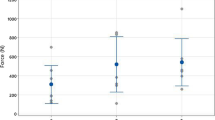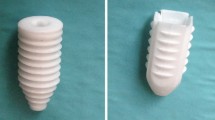Abstract
The purpose of this study was to clarify differences in tendon graft–to–bone tunnel healing between bone-attached tendon grafts with interference-screw fixation and bone-free tendon grafts with extra-articular suture fixation. In 42 Japanese White rabbits, anterior half replacement of the medial collateral ligament was performed using half of the ipsilateral patellar tendon. At the femoral attachment, the bone-plug-attached graft was fixed with an interference screw (group A). The bone-plug-free graft was fixed by the extra-articular suture fixation technique with sutures tied over a button (group B). Biomechanical and histological evaluations were performed at 2, 4 and 8 weeks postoperatively. In biomechanical evaluation, at 2 or 4 weeks 27 of 28 specimens (96%) were pulled out from the femoral tunnel, while one 4-week specimen and all four 8-week specimens failed at the graft’s mid-substance. At 2 weeks, the maximum failure load was 25±10 N and 24±6 N for group A and group B respectively (mean±SD). At 4 weeks, the maximum failure load was 42±17 N and 35±15 N respectively. There were no significant differences in maximum pullout failure load between the groups at 2 or 4 weeks postoperatively. (P=0.887 at 2 weeks and P=0.339 at 4 weeks using ANOVA measurement). Histologically, the bone-attached grafts showed partial bone–to–bone union at the graft–bone tunnel interface at 4 weeks, and complete bony union at 8 weeks. The bone-free grafts exhibited newly formed Sharpey-like collagen fibers at 4 weeks, and strong connection by mature granulation tissue at 8 weeks. Graft–to–bone tunnel healing of bone-attached graft with screw fixation and bone-free graft with extra-articular suture fixation are comparable in terms of biomechanical evaluation during the early postoperative periods.





Similar content being viewed by others
References
Beynnon BD, Johnson RJ, Fleming BC (2002) The science of anterior cruciate ligament rehabilitation. Clin Orthop 402:9–20
Butler DL, Grood ES, Noyes FR et al (1989) Mechanical properties of primate vascularized vs nonvascularized patellar tendon grafts; changes over time. J Orthop Res 7:68–79
Goradia VK, Rochat MC, Grana WA, Rohrer MD et al (2000) Tendon–to–bone healing of a semitendinosus tendon autograft used for ACL reconstruction in a sheep model. Am J Knee Surg 13:143-151
Grana WA, Egle DM, Mahnken R, Goodhart CW (1994) An analysis of autograft fixation after anterior cruciate ligament reconstruction in a rabbit model. Am J Sports Med 22:344–351
Grassman SR, McDonald DB, Thornton GM et al (2002) Early healing processes of free tendon grafts within bone tunnels is bone-specific: a morphological study in a rabbit model. Knee 9:21–26
Ishibashi Y, Rudy TW, Livesay GA et al (1997) The effect of anterior cruciate ligament graft fixation site at the tibia on knee stability: evaluation using a robotic testing system. Arthroscopy 13:177–182
Kurosaka M, Yoshiya S, Andrish JT (1987) A biomechanical comparison of different surgical techniques of graft fixation in anterior cruciate ligament reconstruction. Am J Sports Med 15:225–229
Maeda A, Shino K, Horibe S et al (1997) Remodeling of allogeneic and autogenous patellar tendon grafts in rats. Clin Orthop 335:298–309
Motosugi N, Muneta M et al (1997) The effects of bone graft and preservation of bony attachment on the maturation process of tendon graft. Proceedings of 1997 Annual Meeting of Japanese Society for Clinical Biomechanics, Japan 18:511–514
Nagano J, Shino K, Maeda A et al (1996) The remodelling process of allogeneic and autogenous patellar tendon grafts in rats: a radiochemical study. Arch Orthop Trauma Surg 115:10–16
Park MJ, Lee MC, Seong SC (2001) A comparative study of the healing of tendon autograft and tendon-bone autograft using patellar tendon in rabbits. Int Orthop 25:35-39
Scheffler SU, Sudkamp NP, Gockenjan A et al (2002) Biomechanical comparison of hamstring and patellar tendon graft anterior cruciate ligament reconstruction techniques: the impact of fixation level and fixation method under cyclic loading. Arthroscopy 18:304–305
Tomita F, Yasuda K, Mikami S et al (2001) Comparisons of intraosseous graft healing between the doubled flexor tendon graft and the bone–patellar tendon–bone graft in anterior cruciate ligament reconstruction. Arthroscopy 17:461–476
Toritsuka Y, Shino K, Horibe S et al (1997) Effect of freeze-drying or gamma-irradiation on remodeling of tendon allograft in a rat model. J Orthop Res 15:294–300
Rodeo SA, Arnoczky SP, Torzilli PA et al (1993) Tendon-healing in a bone tunnel. A biomechanical and histological study in the dog. J Bone Joint Surg Am 75:1795–1803
Weiler A, Hoffmann RF, Bail HJ, Rehm O, Sudkamp NP (2002) Tendon healing in a bone tunnel. Part II: Histologic analysis after biodegradable interference-fit fixation in a model of anterior cruciate ligament reconstruction in sheep. Arthroscopy 18:124–135
Weiler A, Peine R, Pashmineh-Azar A, Abel C, Sudkamp NP, Hoffmann RF (2002) Tendon healing in a bone tunnel. Part I: Biomechanical results after biodegradable interference-fit fixation in a model of anterior cruciate ligament reconstruction in sheep. Arthroscopy 18:113–123
Yoshiya S, Nagano M, Kurosaka M et al (2000) Graft healing in the bone tunnel in anterior cruciate ligament reconstruction. Clin Orthop 376:278–286
Acknowledgement
The authors wish to thank Kanae Asai for her technical assistance.
Author information
Authors and Affiliations
Corresponding author
Rights and permissions
About this article
Cite this article
Kawakami, H., Shino, K., Hamada, M. et al. Graft healing in a bone tunnel: bone-attached graft with screw fixation versus bone-free graft with extra-articular suture fixation. Knee Surg Sports Traumatol Arthrosc 12, 384–390 (2004). https://doi.org/10.1007/s00167-003-0484-2
Received:
Accepted:
Published:
Issue Date:
DOI: https://doi.org/10.1007/s00167-003-0484-2




